The content of the article
Since ancient times, people exchange eggs and Easter cakes for Easter. The tradition took shape for many years, as a result of which there were many ways of coloring and decorating paraphernalia. With the words "Christ is risen!" men and women, children and the older generation exchange eggs, later looking at intricate patterns. In addition, the coloring of eggs is a rather fascinating process that can rally households. There are basic methods, consider them in more detail.
How to prepare eggs for painting
As mentioned earlier, experienced mistresses, through trial and error, identified the main options for coloring eggs for Easter. However, regardless of the method chosen, they must first be prepared.
- A few hours before the intended staining, remove the eggs from the refrigerator and leave at room temperature. Such a move will help to avoid a temperature difference, due to which the shell cracks. An alternative is to puncture the shell with a thin sewing needle, which will not allow the eggs to burst.
- If food pigments or onion peel will be used as the main staining method, it is recommended to wash the shell first. To do this, use a kitchen sponge and soda. In the end result, the paint will lie evenly without streaks and spotty spots.
- Before starting the procedure, degrease the shell by wiping it with vodka or medical alcohol. If neither one nor the other is available, clean the surface with soap and water, then rinse and dry thoroughly.
- To give the shell gloss after painting, wipe the surface of the eggs with vegetable or corn oil. Do not use cotton pads for these purposes, gently moisten the fingers in the composition, then spread them over the shell.
When you have prepared the “material”, proceed to painting. Choose the best option for yourself, and then clearly follow the instructions.
Method number 1. Food colorings
Food coloring is rightfully considered the most common type of color for Easter eggs. You can buy ready-made colors or display your own shades. Pigments can be pearlescent, glossy or matte, it all depends on the manufacturer.
To properly prepare the composition, take care of such a number of containers in advance that there is a separate bowl for each color. Dilute the paint with water at room temperature, there should be plenty of liquid so that the eggs in it completely drown.
After diluting the paint, add 30 ml. table vinegar solution, then send cooked or raw eggs to the bowl. The exposure time varies, it all depends on how intense the shade you want to get.
Stencil
- Get tracing paper - ultrathin paper on the Internet or in a stationery store. Cut out any image in the form of a stencil from it (the inner part is removed). Anything is suitable as a drawing: your favorite cartoon characters, Easter themes, Jesus Christ, etc.
- A snapshot for the stencil can be downloaded on the Internet. The final result depends on the quality of the original image and the material itself. When you make a stencil base, namely print and cut it out, moisten the paper in room temperature water. The material should become elastic, repeating the shape of an egg.
- Attach the stencil to the shell, smooth the creases. If your drawing is small, duplicate it in several places. Fix the stencil with gauze or a piece of nylon stockings (tights).
- Dilute the food or natural dye, send eggs to it and cook them until tender. At the end of the procedure, remove the eggs, put them on toothpicks or a newspaper, cool to room temperature. As soon as this happens, remove the cheesecloth and stencil, enjoy the result.
Vegetable oil
- A beautiful result is achieved as a result of coloring eggs with the addition of vegetable oil. To perform the procedure correctly, prepare two containers with the same shade. Pour oil into the first, and leave the second unchanged.
- Cook hard-boiled eggs, cool to a temperature of 30 degrees (the coloring composition should have the same indicator). Dip the “material” in a bowl of paint, wait for the required interval (the exact date is indicated in the instructions).
- After that, remove the eggs, leave the paint to dry. When this happens, send the product to a second container with vegetable oil, again wait time. Dry the eggs, evaluate the result.
Insulating tape
- Cut the electrical tape along to make thin strips (you can skip this step if desired). Prepare several containers with diluted paint, it is preferable to choose blue and yellow colors.
- Stick a strip in the form of a spiral or any other pattern as you wish. Dip the eggs in a blue bowl, wait a while, remove and wait to dry. Remove the electrical tape.
- Now glue the following strips, which will slightly cover the previously obtained pattern. Dip the egg in the yellow paint, wait for the interval, remove and dry.
- You will end up with a yellow egg with blue and green stripes. The option is good in that it allows you to experiment with obtaining new shades by applying one color to another.
Stationery erasers
- Get in the stationery store gum, which usually pull the banknotes (silicone base). Hard boil the eggs, cool, prepare the paint in one or more shades.
- You can proceed in two ways. The first involves the coloring of the egg in any color with prominent white lines (elastic bands are attached to a previously unpainted egg). The second option consists in two-phase coloring, as a result of which the lines are obtained of the color in which the egg was painted originally.
- Consider the second option, it is more complex. Color the egg yellow, dry. Wrap stationery gum randomly in a criss-cross pattern. Dip the “material” in the green paint, wait for the pigment to set. Dry, remove gum. You will see the egg turn blue with yellow stripes.
Plant leaves
The technique is similar to the stencil technique with only one clarification - plant leaves are used as a pattern, most often in their role is parsley and dill.
- To get the exact result, tear off a few leaves, attach them to the shell, fix with gauze or nylon stocking. Dip in the paint, wait a while.
- At the end of the time, remove the eggs, cool and dry them. Expand the fixing material, remove the leaves, grease the surface with vegetable oil and enjoy the result.
- An alternative to leaves can be the same insulating tape, self-adhesive paper or scotch tape. Cut out the picture you need from the material, attach to the fat-free shell of a pre-cooked egg. Place the product in a bowl of pigment, then remove and dry.
Method number 2. Natural dyes
- Onion husks, beets, turmeric, carrots, birch leaves, calendula, orange or lemon, spinach, red cabbage, nettle, coffee can serve as natural dyes.
- The main feature of "folk" staining is considered to be that the composition is slow. As a rule, it takes about 8-10 hours to get the result.
- To prepare the solution, pour water into the pan and add a large amount of the selected dye. Pour in 35 ml. table vinegar, mix. Bring the solution to the appearance of the first bubbles, then reduce the power and boil for another 15 minutes.
- When the paint is ready, insist it on the order of half an hour, then send the eggs to the container and simmer them over low heat for 25 minutes. Then turn off the burner, leave the product in the solution overnight.
Turmeric
To give the eggs a seductive golden hue, use ground turmeric.
- Boil water in an enamel pan, pour 90 g. turmeric, bring to a boil. Place the raw eggs in the bowl, cook them until cooked, then let them brew for another 8 hours without removing them.
- It is recommended to carry out the procedure with extreme caution, since it is quite difficult to remove turmeric from the surface of furniture and clothes, however, like other natural dyes.
Red cabbage
A broth based on cabbage will give the eggs a rich blue tint.
- Grind the whole head in small slices, place in a saucepan and pour boiling water over it. Add 180 ml. table vinegar, cover and leave for 10 hours.
- After the expiration date, send the eggs to the container, control the color intensity every 2 hours. Then remove the product and let it dry. If desired, paint the surface with gouache or felt-tip pens.
Beet
Beets will help to color the eggs in a raspberry or pinkish tint, it all depends on the duration of exposure of the product in the solution.
- Grate 4 medium-sized beets on a grater, then mash the resulting composition with a potato nipper or grind in a blender.
- Pour the mixture with boiling water so that the water completely covers the beets. Pour in 150 ml. vinegar concentration of 9%, wait 6 hours.
- Put boiled eggs in a pan, let it brew for 5 hours. After time, remove the product, leave to dry.
Onion husk
Onion peel will paint eggs in a reddish brown shade with a bronze tint
- To prepare the coloring solution, you will need to take a husk of 4 kg or more. Luke. Raw materials must be sent to a large pot and pour boiling water over with boiling water.
- Put the container on the stove, bring the mass to a boil and simmer for 1 hour. After that, cover, leave to infuse for 24 hours.
- After the set period, pass the broth through a colander or cheesecloth, cook eggs in it for about 10 minutes. Then do not remove the product from the pan, leave it to cool completely.
How to make patterns on eggs
Regardless of the chosen coloring method, you can create patterns on Easter eggs with the help of improvised materials.
Rice
- Cook round-grain or long-grain rice, soak the egg in water and roll it in the rice so that the grains stick. Tie with stocking or gauze, fix on both sides with elastic bands.
- Prepare a coloring pigment, dip eggs in it and wait for the required period of time. For this method, natural dyes are better.
- When the eggs are colored, remove them and leave to dry completely. Remove the fabric, remove the rice, grease the surface of the shell with sunflower oil.
Silk fabric
Eggs can be dyed with fabrics, silk or cotton with existing patterns is ideal for these purposes.
- Moisten the egg in hot water, wrap a cloth with a flap so that the pattern fits snugly on the surface of the shell with the front side. Sew the egg around the perimeter so that the fabric does not slip.
- Wrap a piece of nylon, tie on both sides, creating a kind of candy. Pour 100 ml into an enameled pan. vinegar (6%), add water, send to the eggs. Cook them for about 15 minutes, then turn off the stove.
- Let the eggs stand in the solution for another quarter of an hour, then place them in a bowl of cold water and leave to cool completely. Carefully remove the latch and stocking, evaluate the fruits of your labors.
First, prepare the eggs for painting: remove them from the refrigerator, leave them at room temperature, pierce a thin hole in the shell with a sewing needle. Consider staining with food or natural dyes. Use a stencil, parsley leaves, silk fabric or improvised materials to create a unique design.
Video: how to paint eggs for Easter (different ways)

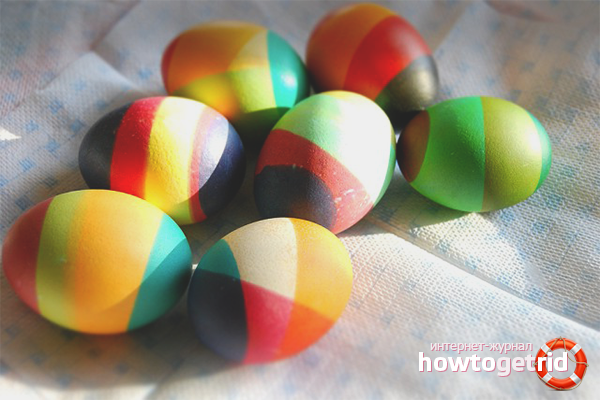
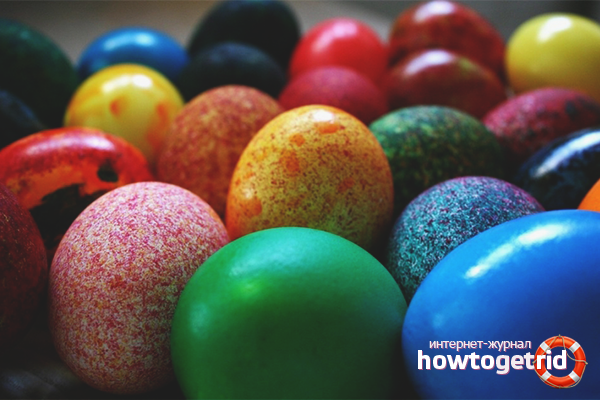
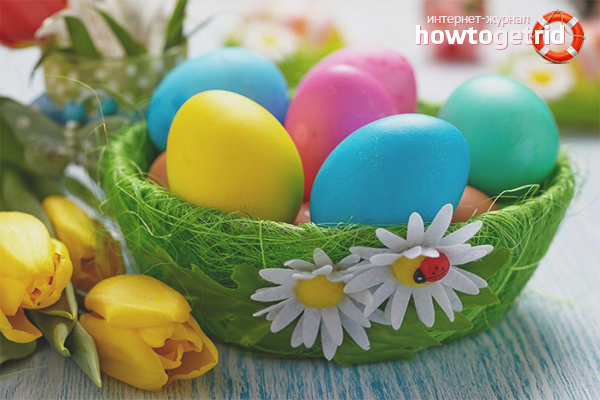


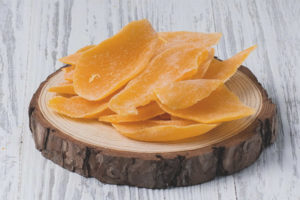
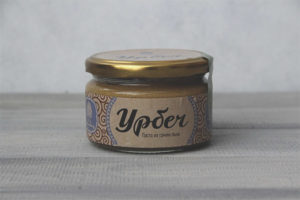
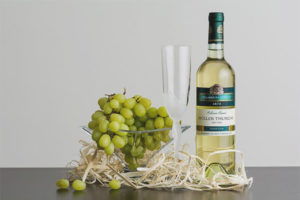
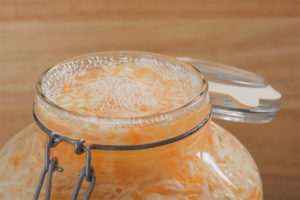
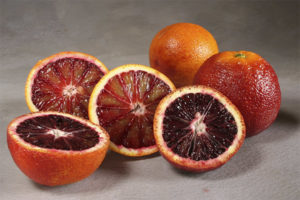


Submit